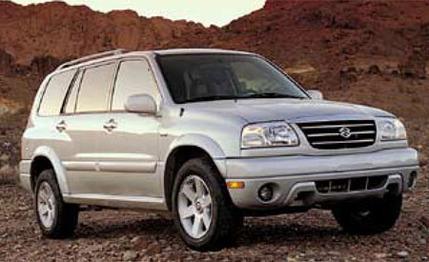
 Short Take Road Test
Short Take Road Test
Imagine a freshman kegger moments after the last ounce of Hamm's has been bonged and a belch before sunrise. In the dorm hallway, residual stupor opens the universe to contemplation by the residents.
"What if Spartacus had had a Piper Cub?"
"Why can't we play CDs backward?"
"What if Suzuki stretched the Grand Vitara's wheelbase more than a foot?"
A few hours later everyone wakes up sober and forgets all about transcendent nonsense. A few years later, they don't even remember being young.
But at Suzuki, they went and stretched the five-passenger Grand Vitara to produce the seven-seater Grand Vitara XL-7. Those scamps are in touch with the cosmos.
From the B-pillar forward, the XL-7 is pure small-SUV Grand Vitara (that sheetmetal is shared). And from the B-pillar back it's, well, pretty familiar, but longer. The 12.6-inch wheelbase stretch is a straightforward splice -- the basic ladder frame is retained, and the general specifications of the independent-front-strut and coil-sprung, solid-axle-rear suspension are unchanged. The rear doors are lengthened and wrap less over the wheel wells, and although the new sheetmetal behind those wells stretches the XL-7 another 6.6 inches, it winds up at a familiar tailgate.
The XL-7 is 19.2 inches longer than a Grand Vitara (GV from here on), which makes it a bit larger than most other players in the Toyota RAV4/Honda CR-V cute-ute class, yet smaller than the Ford Explorer/Chevrolet Blazer mainstream-SUV class. Despite its still relatively diminutive dimensions, Suzuki somehow crams a third-row seat into every XL-7. Not a very roomy third-row seat, but it's there, it bumps the nominal passenger count to seven, and it can't be removed. That makes this the least expensive and smallest seven-seat SUV.
With the heaviest four-wheel-drive XL-7 coming in at a claimed 3750 pounds, it's about 550 pounds porkier than a GV. To handle the heft, all XL-7s get a 170-horsepower, 2.7-liter version of Suzuki's all-aluminum DOHC 24-valve V-6. The displacement bump from the GV's 155-hp, 2.5-liter version of the V-6 results from a bore 4mm larger and hardly affects the engine's bland vice- and passion-free character. The 178 pound-feet of torque peaks at 4000 rpm, and in most situations there's enough grunt to keep out of trouble. The engine is backed by either a five-speed manual or four-speed automatic, and a two-speed manual transfer case on four-wheel-drivers.
As expected, the long wheelbase nets a smoother on-road ride for the XL-7 than the GV gets, but otherwise, they're quite similar. The rack-and-pinion steering communicates well with the driver but isn't telling an interesting story, the acceleration is modest, and the front-disc, rear-drum brakes have a nice feel with ABS standard on higher-trim models. All XL-7s come riding on pavement-oriented P235/60R-16 tires.
Whatever the trim level (Standard, Plus, Touring, or leather-lined Limited), the XL-7 interior is relatively large but relatively inflexible. A thin storage bin bolted to the floor behind the split third-row seat sort of flattens out the load floor when that seat is folded down, but it effectively raises the load height and cuts vertical clearance. When the second and third rows are folded, Suzuki claims 73 cubic feet of space, but it's a lumpy floor on which to set cargo. That the third seat can't be removed or doesn't disappear borders clearly on the inexcusable.
The XL-7's advantage will be price. The base rear-drive model starts at about $20,000 and significantly undercuts competition like Nissan's similarly powerful five-passenger Xterra. Even the four-wheel-drive Grand Vitara XL-7 Limited (that's almost every vehicle-naming cliche in the book) should come in at $25,000 when it arrives this spring.
Because of its size, the XL-7 nudges Suzuki into the heart of the SUV market. But it's a stopgap, a product of undergraduate whimsy in competition with grown-up machines.